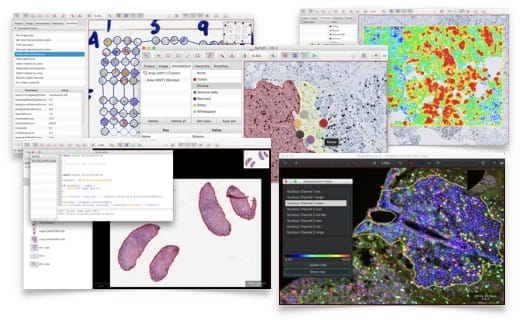Open Microscopy Environment (OME): Digital Pathology Redefined with Open source
Table of Content
OME (Open Microscopy Environment) is an open-source initiative aiming to produce open-source software and format standards for microscopy data. The project is started by researchers from the University of Dundee, later it gathered the attention and support from researchers, developers, & scientists from all over the world, from universities, institutes, laboratories, companies, & open-source developers.
OME projects
OME's team had released 3 projects that have a great impact on digital pathology. Here we will provide an overview for all of them:
1- OMERO

OMERO is an open-source client-server solution that provides a platform for managing, visualizing, & analyzing microscopy imaging. It's a complete solution to manage whole-slide images with powerful features to build applications over it or use it with an existing application.
OMERO is built on a solid architecture, It has a developer friendly-API, multiple clients for different operating systems, It also supports multiple programming languages.
OMERO is used as an optional microscopy imaging server in Orbit (Whole-slide image analysis platform with BigData and Machine learning/ Deep learning support).
Orbit is an open-source virtual slide/ whole-slide image analysis that supports machine learning, deep learning, & big data (Apache Spark). It's built for researchers and AI software specialists. Read our snap review about it here: Orbit: Digital Pathology meets AI (Machine learning & Deep learning) & Big Data with Open-source flavour.
Highlights:
- Clients (Linux, Windows, & macOS) / Server/ Plugins (Fiji, Matlab)
- Java, Python, REST API
- The OMERO API allows clients to be written in Java, Python, C++ or MATLA
- The OMERO platform includes a Java client OMERO.insight, a Python-based web client OMERO.web, a Command Line Interface which uses Python, and a Java ImageJ plugin.
- Work with your data in Python, Java, MATLAB, and C++.
- Server scripting with Python
- Analysis support by OMERO server using database tables
2- Bio-formats
Bio-Format is a community-driven Java library for reading, & writing microscopy image files, & metadata. It uses standardized, open formats.
Bio-Format is used OMERO as well as some powerful medical image analysis programs like ImageJ, CellProfiler, & Icy. It can be used with Matlab as well.
Bio-Formats 5 improves support for High Content Screening, time-lapse imaging, digital pathology, and other complex multidimensional image formats, reading over 150 file formats and their metadata to the OME data model standard. [src:OME]
Bio-Formats Java API, which supports reading of over 140 file formats and writing of over 15 file formats. [src:OME]
3- OEM files OME-TIFF
OEM files are similar to BioFormats but it's focused on specific file type: OME-TIFF. It reads and writes OME-TIFF files with support of OEM data model, which eases the visualization and analysis for OEM-TIFF files.
OEM files is available for download for Linux (Ubuntu), Unix (FreeBSD), macOS (10.12 and later), CentOS (7.3, & 6.9), & Windows (32-bit, & 64-bit). OEM also offers the source code.
OEM License
The source code for OMERO, & BioFormats are released under GPLv3, However, there is a commercial license from
Glencoe Software, a company that formed by members of the OEM's core team, It provides commercial-based solutions and custom solutions based on OME products.
Bio-Formats:
Under the terms of the GNU public "copyleft" license, any software package linking to Bio-Formats, either directly or indirectly, cannot be distributed unless its source code is also made available under the terms of the GPL. Some components which provide reader and writer implementations for open file formats are released under a more permissive BSD-2 license which enables non-GPL third-party software. For a complete list of which file formats are included in the BSD license, see the BSD column of the supported formats table. Developers of non-GPL software wishing to leverage Bio-Formats components not covered by the BSD license may purchase a commercial license from Glencoe Software.
OEM files:
OEM files is released under the BSD-2 license.
Resources
Conclusion
OME provides a solid infrastructure for Digital Pathology, for research, building clinical diagnosis applications, & education. It provides developers with open source software packages that allow them to build production-ready digital pathology applications with powerful features. It supports multiple-platform, and it's battle-tested with several productions. OEM is maintained and continuously developed & improved by groups of researchers include biologists, software engineers, software developers, & bio-informatics specialists, which it's unlikely to be abandoned or discontinued in the near future.
Whole-slide Image Analysis
Open source Free Whole-slide Image Viewers and Analysis Software











